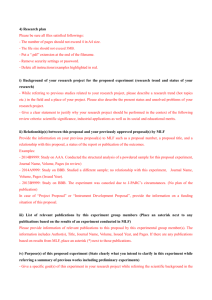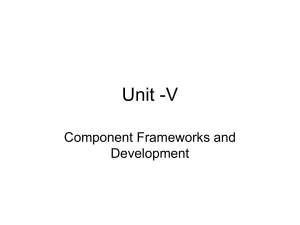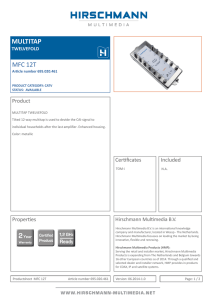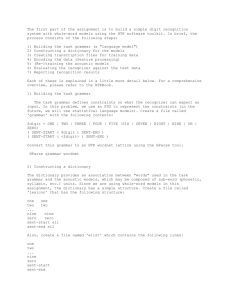Accent Identification for Saudi Speakers
advertisement
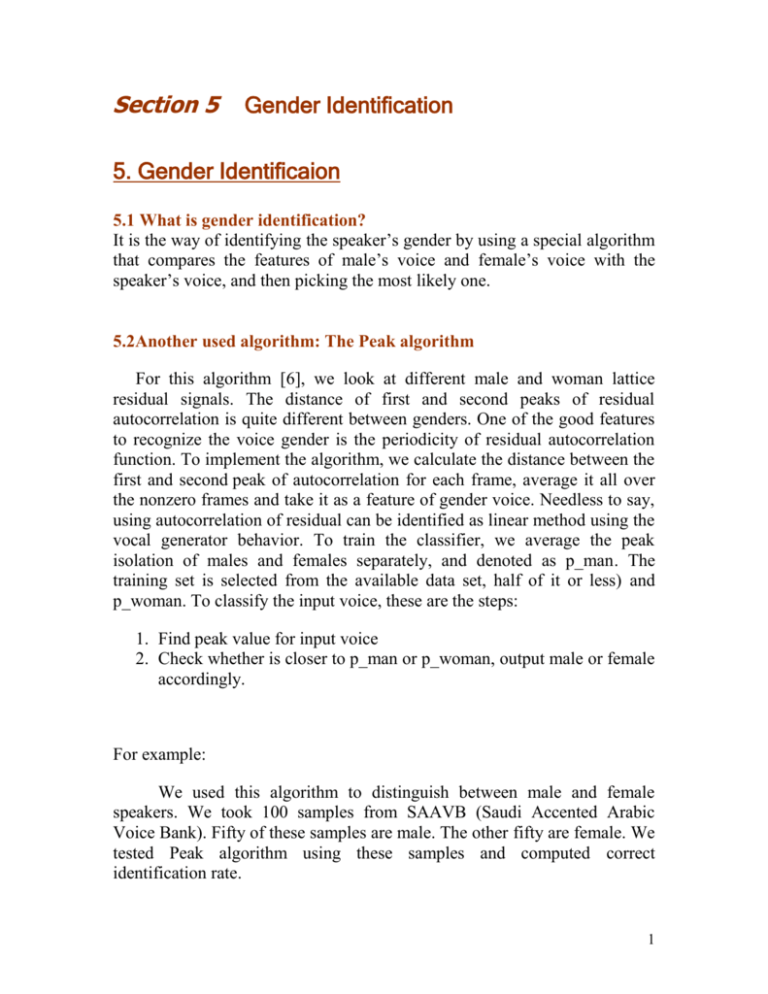
Section 5 Gender Identification 5. Gender Identificaion 5.1 What is gender identification? It is the way of identifying the speaker’s gender by using a special algorithm that compares the features of male’s voice and female’s voice with the speaker’s voice, and then picking the most likely one. 5.2Another used algorithm: The Peak algorithm For this algorithm [6], we look at different male and woman lattice residual signals. The distance of first and second peaks of residual autocorrelation is quite different between genders. One of the good features to recognize the voice gender is the periodicity of residual autocorrelation function. To implement the algorithm, we calculate the distance between the first and second peak of autocorrelation for each frame, average it all over the nonzero frames and take it as a feature of gender voice. Needless to say, using autocorrelation of residual can be identified as linear method using the vocal generator behavior. To train the classifier, we average the peak isolation of males and females separately, and denoted as p_man. The training set is selected from the available data set, half of it or less) and p_woman. To classify the input voice, these are the steps: 1. Find peak value for input voice 2. Check whether is closer to p_man or p_woman, output male or female accordingly. For example: We used this algorithm to distinguish between male and female speakers. We took 100 samples from SAAVB (Saudi Accented Arabic Voice Bank). Fifty of these samples are male. The other fifty are female. We tested Peak algorithm using these samples and computed correct identification rate. 1 Figure 11: The gender correct identification rate in our experiment You can see from Figure 11 the result of testing samples from SAAVB using Peak algorithm. You can find that there are 27 male speakers have been identified correctly and 43 female speakers have been identified correctly. We can see that female speakers have a better ratio of identification. We think that the reasons are: 1- Some of the speech files have noise. 2- Maybe some of male sounds look like female sounds. But not the other way. We tried to determine the constants p_man and p_woman by taking the average of the peaks for the male samples for p_man and the average of the peaks for the female samples for p_woman. After doing the same test, we have found that the successful rate has decreased to %68. We also found that the male identification has increased but female has decreased. 5.3 How to use HTK for Gender Identification: 5.3.1 Training step: It is known that HTK is normally used for speech recognition. But we used it in a special way to make it identify gender. First thing we have to install HTK. Then, we define the file “monophones” and wrote in it: 2 m f After that, we defined the dictionary file “dict” and we wrote in it: MALE m FEMALE f Then, we defined the file “gram” which contains the final results. We wrote in it the following: (MALE|FEMALE) Also, we used two ready files called “config1” and “config2”. They can be found in the HTK book. They are representing the configuration files that prepare the system to convert the WAV files to MFC files. The MFC files contain an attribute for the voice represented as array of numbers. For each file e.g. “m1.wav” we create a label file “m1.lab” which contains: -1 -1 m If it was a male or: -1 -1 f If it was a female. This labeling is used to train the system to identify the gender. After that we create a file called “codetr.scp” which contains the train list of WAV files and the output name for the MFC files. E.g.: m_train1.wav m_train1.mfc f_train1.wav f_train1.mfc ...etc 3 Then, we create a file called “train.scp” which contains the train list of MFC files. E.g.: m_train1.mfc f_train1.mfc …etc After that we create a file called “words.mlf” which contains the list of label files and the digit labeling. E.g.: #!MLF!# "'*'/m_train1.lab" m . "'*'/f_train1.lab" f ....etc Also, we create another file called “proto” contain prototype model. We took this prototype model from the HTK book. Then, we create a directory called “hmm0”. After that we run the following commands:“hcopy -T 1 -C config1 -S codetr.scp” : This command is used to convert the WAV files to MFC files using the configuration parameters in the file “config1”. “hcompv -C config2 -f 0.01 -m -S train.scp -M hmm0 proto” This command used to compute the global mean and covariance for set of data. This command will generate two files in the folder hmm0// called “vfloors” and “proto”. 4 Then, we create two new files in the hmm0 directory. The first file is called “macros” contain: ~o <VecSize> 39 <MFCC_0_D_A> The previous lines are always the same in every “macros” file. The next lines are the content of the “vfloors”. The second file is called “hmmdefs” which contains a copy for each of the required monophones HMMs. It is build manually using a copy of the prototype HMM “proto”. Then we run the following commands to re-estimate the parameters of a set of HMMs. “herest -C config2 -I words.mlf -t 250.0 150.0 1000.0 -S train.scp -H hmm0/macros -H hmm0/hmmdefs -M hmm1 monophones” This will produce the re-estimated parameters of the HMMs in the folder hmm1. Then, we repeat this step several times. We do it three more times: “herest -C config2 -I words.mlf -t 250.0 150.0 1000.0 -S train.scp -H hmm1/macros -H hmm1/hmmdefs -M hmm2 monophones herest -C config2 -I words.mlf -t 250.0 150.0 1000.0 -S train.scp -H hmm2/macros -H hmm2/hmmdefs -M hmm3 monophones herest -C config2 -I words.mlf -t 250.0 150.0 1000.0 -S train.scp -H hmm3/macros -H hmm3/hmmdefs -M hmm4 monophones”. We tried to do more re-estimations but after we saw the results, we find that four times is the best choice. 5.3.2 Testing step: Here we used hmm4 which is the output from the training step. The following files are the same as what we already explained in the training step: “dict”, ”monophones”, “gram”, “config1” and “hmm4”. 5 Then, we create a file called “codets.scp” which contains the test list of WAV files and the output name for the MFC files. E.g.: m_test1.wav m_test1.mfc f_test1.wav f_test1.mfc ...etc Then, we create a file called “test.scp” which contains the test list of MFC files. E.g.: m_test1.mfc f_test1.mfc …etc After that we create a file called “wordtest.mlf” which contains the test list of the label files and the words labeling. E.g.: #!MLF!# "'*'/m_test1.lab" MALE . "'*'/f_test1.lab" FEMALE ....etc Then, we run the following commands: “hcopy -T 1 -C config1 -S codets.scp”:We have explained it in the previous training step. “Hparse gram wdnet”:- 6 This command is used to convert the grammar to specific format, so that the HTK can understand it. “hvite -H hmm4/macros -H hmm4/hmmdefs -S test.scp -l '*' -i recount.mlf w wdnet -p 0.0 -s 5.0 -o TS dict monophones”:This command is used to generate the “recount.mlf” file which contains the final recognition result of every file in the “test.scp”. “hresults -I wordtest.mlf monophones recount.mlf” This will output the percentage of correct recognition by comparing the file “wordtest.mlf” with the file “recount.mlf”. 7
